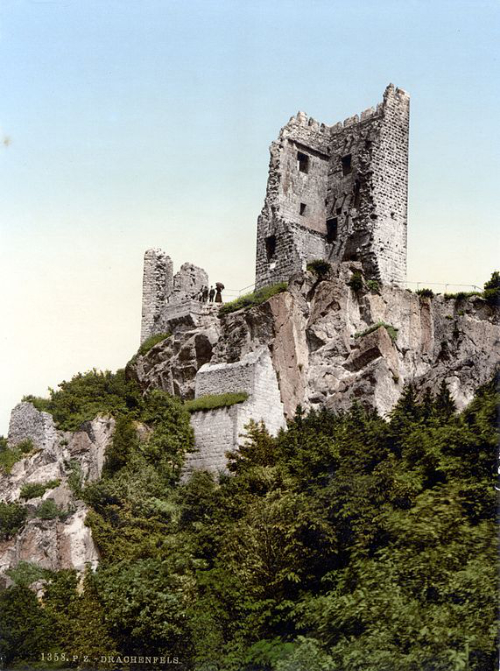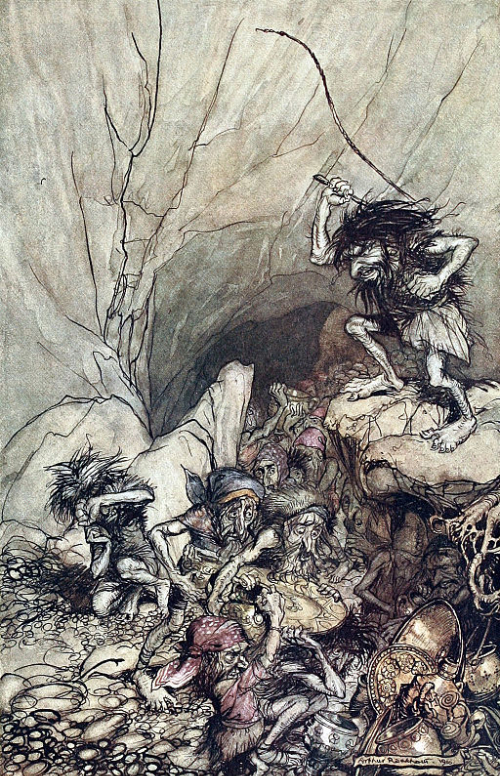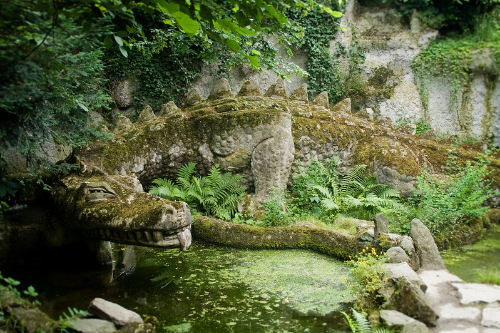If we head to the Siebengeberge uplands in Germany, we’ll find a hill named the Drachenfels near Königswinter. It stands at 321 m and the name translates as Dragon’s Rock, named after a dragon that allegedly lived on its slopes. It’s also not far from the Lorelei Rock, so named for the seductive water nymph that apparently caused countless boat accidents.
Ruins of a 12th-century castle, the Burg Drachenfels, cling to the top of the mountain. The castle is one of the oldest, if not the oldest, in the area. Protestant Swedes destroyed the castle in 1634 during the 30 Years’ War, and left ruined. The Drachenfels even appear in Lord Byron’s Childe Harold’s Pilgrimage.

Given we’re in the Folklore of Mountains and Hills Month, let’s investigate two legends associated with the dragon of the Drachenfels…
The Drachenfels and Epic Poetry
The Drachenfels is an early location in the Nibelungenlied (Song of the Nibelungs), a Middle High German epic poem written in c. 1200. The epic poem takes the form of two parts. In the first, we hear the story of Siegfried, who marries the princess Kriemhild. The second part focuses on Kriemhild and her later marriage to the King of the Huns.
The Nibelungenlied went on to inspire Richard Wagner’s epic opera, Der Ring des Nibelungen in 1857 and Fritz Lang’s silent film duology, Die Nibelungen, in 1924. Certain groups misused interpretations of the poem to identify characters with nationalistic ideas, with Siegfried particularly associated with German nationalism.
I won’t delve into the wider plot here, since the episode we’re interested in only concerns the Drachenfels. It appears in the third chapter, in which Hagen von Tronje tells the king about some of Siegfried’s adventures. There are several variations on the story, given the number of manuscripts for the poem, and this version comes from Eugen Hollerbach’s Rhine Legends (2007).
The Legend of Siegfried
Siegfried was a Franconian prince and grew from an adventurous boy into a headstrong warrior. Having exhausted the possibilities for excitement at home, he set out to gain more experience of the world. He travelled along the Rhine, eventually coming across the land of the Nibelungs, dwarfs famous for their skill in crafting. Siegfried sought work as an apprentice, and the king himself agreed to take him on for a year.

At the end of the year, Siegfried discovered that the king had secretly been crafting brilliant treasures. Upset that the king didn’t trust him enough to let him help, Siegfried lost his temper. He snatched up one of the hammers and slammed it into one of the anvils so hard that it drove it ten fathoms underground. The king realised Siegfried’s strength far outmatched his own abilities, and he tried using flattery to calm the hot-headed hero. Eventually, he asked Siegfried to run an errand for him, to collect charcoal from the brazier of a mighty giant.
Treachery!
Normally, the giant brought the charcoal to the king. Unbeknownst to Siegfried, the king had left instructions with the giant. If he ever sent anyone to the giant, the giant should kill him. So when Siegfried arrived at the brazier, the giant seized him by the throat. Siegfried realised he was in trouble, and managed to wriggle free. When the giant uprooted an oak tree and swung it at Siegfried, the hero ducked, and lashed out with the sword he’d made himself.
He severed the giant’s foot, and when the giant fell to the ground, Siegfried darted forwards and severed his head too. He set off back to the Nibelungs, tired and furious.
The king didn’t expect to see Siegfried again, so in his absence, he’d laid out all his treasures so he could admire them. When Siegfried returned and saw the treacherous king, rage seized him. Siegfried dispatched the king and hid all of the treasure under the floor. He went in search of a better hiding place.
He came upon the scene of a village preparing for the annual sacrifice of a virgin to the dragon that lived on the hill. Siegfried caught sight of her, and felt so awful for the weeping maiden that he hurried up the Drachenfels to try to save her. Only killing the dragon would end its reign of terror.
Enter the Dragon
Siegfried took a steeper route up the hill than that of the villagers and reached the dragon before they did. The dragon roared, furious that this young man stood before him, and not the terrified girl he normally devoured. But the dragon had thick scales and horns along his spine, so he didn’t fear Siegfried. He crouched down for a better look at the hero. Siegfried attacked, but his sword merely glanced off the beast’s neck.
The dragon breathed a thick plume of fire at Siegfried but he dived out of the way. Irritated by the bravado, the dragon opened his jaws again. Siegfried threw a bundle of dry wood into the dragon’s mouth. It caught fire in the dragon’s flames, and the dragon screamed, thrashing his head in pain. Exposing the soft flesh of his throat, Siegfried drove his sword into the dragon’s weak spot, and the dragon fell to the ground.

Some of the dragon’s blood splashed onto Siegfried’s hand. When he looked closer, he realised the skin had become hard, like the scales of the dragon. He threw his clothes off and coated himself in the dragon’s blood.
He managed to coat himself everywhere, except a spot on his upper back between his shoulders where a linden leaf had fallen. By the time he realised, the dragon’s blood had dried.
Siegfried hacked off the dragon’s head and went back down the hill. He freed the maiden, rebuked the villagers for not fighting the dragon, and took the maiden back to her people. Siegfried returned to the dwarfen forge and retrieved the treasure. He took it back to the dragon’s cave, and buried them where no one would ever find them.
You might have guessed that the story ultimately doesn’t end well for Siegfried. After all, the business with the dragon’s blood sounds a lot like the story of Achilles. His mother Thetis makes him invulnerable by dipping him into the River Styx. Because she holds him by the heel as she does so, she creates his weak spot that still bears his name to this day – the Achilles heel/tendon.
The Other Legend
Yet that’s not the only legend associated with the Drachenfels. Another tale takes us back into the mountain’s pagan past, and was retold by Lewis Spence in his 1915 book, Hero Tales and Legends of the Rhine.
Long ago, a dragon lived in a cave on the Drachenfels. The pagan peasants worshipped the creature and offered human sacrifices. These helped to stem the dragon’s appetite, keeping it from eating farm animals and local people. Two warrior princes, Rinbod and Horsrik, often raided the Christian settlements across the Rhine, seizing captives to offer as sacrifices.
One day, they got their prisoners back to their own land, and started dividing the captives. A Christian maiden caught their eye, and such was her beauty that they fought over her. Both wanted to marry her, but neither would relinquish their claim. When they couldn’t solve the argument through words, they decided to fight with weapons. The victor would win the maiden.
The priests finally intervened, not wanting to risk losing skilled warriors in combat. They decreed that since neither could decide who would have the maiden, and a Christian one at that, they’d offer her as a sacrifice to the dragon.
With some annoyance, the princes agreed, but Rinbod hated the judgment. He loved the maiden, seeing her as more than just a prize, but his pleading with the priests got him nowhere. She would die the following day.
The next day, the priests led the maiden to a clearing outside the cave and tied her to an oak tree. The dragon always emerged at dawn, so everyone waited in the half-light of morning for the dragon to appear.
As you can imagine, the villagers murmured with excitement, keen to see the dragon devour the devout Christian. Horsrik watched with disinterest, glad that if he couldn’t have her, no one would. Rinbod, however, watched with a heavy heart. The calm resolution of the maiden impressed him; no warriors entered battle with such a steadfast spirit.
Dawn broke, and the dragon hauled itself from the cave. Smoke drifted from its nostrils, and it bared its fearsome teeth at the onlookers. Still, the maiden seemed to show no fear. She greeted its approach with a hymn, singing praise for her god while the dragon roared. It grew close enough to pounce, and the maiden made her move. She held out her crucifix and the dragon threw itself to one side, desperate to evade the holy symbol. It crashed over the side of the cliff and fell into the Rhine below.
The villagers dropped to their knees in shock and awe, and Rinbod ran down to free the maiden. Despite the best efforts of the priests, the villagers chose to convert to Christianity. Rinbod finally married the maiden, and built Burg Drachenfels in her honour. While we’ve lost the maiden’s name over the centuries, the legend still marks her bravery.
What Do We Make of the Legends?
So did the legend come first, or the name of the hill? I only ask because Lewis Spence notes that some people doubted the authenticity of the legend of Rinbod and the Christian maiden. I mean, it features an actual dragon so you can see their point.
Yet these same people thought the name might come instead from “Trachyt-fels, meaning ‘Trachyte-rock'” (1915: 154). As Spence explains, another hill near Mannheim bears the name ‘Drachenfels’ and has a similar geology, albeit without the legend. Spence doubted that “the people of antiquity would bestow a geological name upon any locality” (1915: 154).
That said, people have quarried trachyte ore on the hill since the Romans. Builders used stones from the hill to build the St. Maria im Kapitol church in Cologne in c. 1000 (Cherrygarden 2020). So it’s entirely possible the name comes from the geology, and the legend came later to ‘explain’ the name choice.
Perhaps that’s why it became such an obvious location in the Nibelungenlied. Either way, the similarity between the Siegfried version and the Spence version focuses on a maiden being sacrificed to a dragon. Where one hero frees her and returns her home, the other marries her. There’s no sense Siegfried frees her because he fancies her, rather because it’s the right thing to do. Which perhaps makes his victory more noble.
Visiting the Drachenfels
I highly recommend a visit if you’re in the Cologne or Bonn area. You can take a tram to the top of the Drachenfels and then walk back down (as I did in 2013). Or you can walk to the summit if you’re more ambitious.
Visit the ruins of the castle at the summit for excellent views of the Rhine.
Schloss Drachenburg stands further down the hill, built by Baron Stephan von Sarter in 1882. It’s a neo-Gothic confection, though surprisingly, Sarter never lived at the castle, choosing instead to live in Paris. Sarter died in 1902 and his nephew, Jakob Biesenbach, bought the castle from the state. He turned the castle into a tourist attraction, although it was also a boarding school in the 1930s. During the early 1940s, it housed a Nazi elite school, before US soldiers occupied the castle after the war. The castle finally became a listed monument in 1986 (Schloss Drachenburg, no date).
There’s also a museum partway down the mountain. The Nibelungenhalle is dedicated to the Nibelungen saga, while there’s also a reptile zoo. The Dragon’s Den next door reputedly marks the spot where Siegfried defeats Fafnir (see the statue above). If you’re a fan of our scaly friends, it’s definitely worth popping in!
Which legend do you prefer?
References
Cherrygarden, Fred (2020), ‘Burg Drachenfels’, Atlas Obscura, https://www.atlasobscura.com/places/burg-drachenfels.
Hollerbach, Eugen (2007), Rhine Legends, Pulheim: Rahmel Verlag (affiliate link).
Schloss Drachenburg (no date), ‘The History of Drachenburg Castle’, Schloss Drachenburg, https://schloss-drachenburg.de/index.php/en/discovery-tour/history.
Spence, Lewis (1915), Hero Tales and Legends of the Rhine, London: GEORGE G. HARRAP & COMPANY.
Nutty about folklore and want more?
Add your email below and get these posts in your inbox every week.
You'll also get my 5-step guide to protecting your home using folklore!












Have your say!